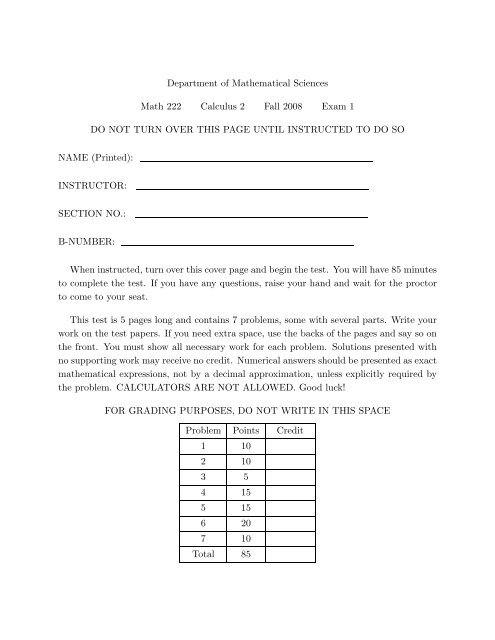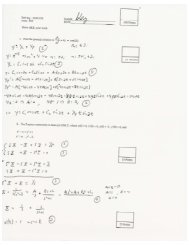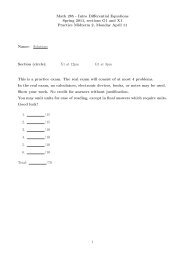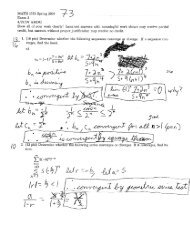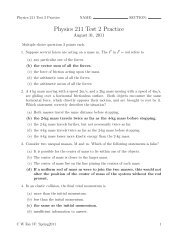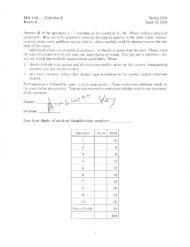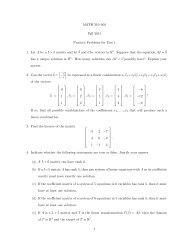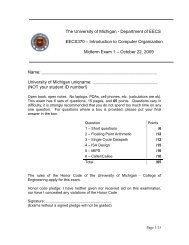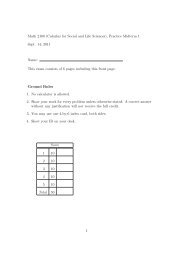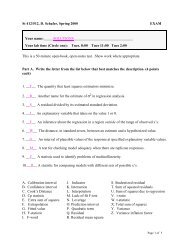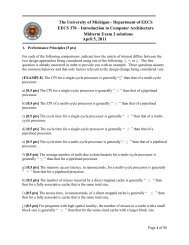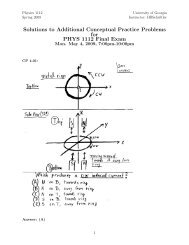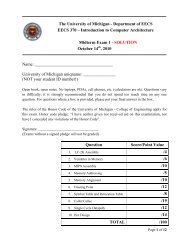Math 222 – Practice Exam 1 w Solutions 2011 – Calculus 2
Math 222 – Practice Exam 1 w Solutions 2011 – Calculus 2
Math 222 – Practice Exam 1 w Solutions 2011 – Calculus 2
Create successful ePaper yourself
Turn your PDF publications into a flip-book with our unique Google optimized e-Paper software.
Department of <strong>Math</strong>ematical Sciences<strong>Math</strong> <strong>222</strong> <strong>Calculus</strong> 2 Fall 2008 <strong>Exam</strong> 1DO NOT TURN OVER THIS PAGE UNTIL INSTRUCTED TO DO SONAME (Printed):INSTRUCTOR:SECTION NO.:B-NUMBER:When instructed, turn over this cover page and begin the test. You will have 85 minutesto complete the test. If you have any questions, raise your hand and wait for the proctorto come to your seat.This test is 5 pages long and contains 7 problems, some with several parts. Write yourwork on the test papers. If you need extra space, use the backs of the pages and say so onthe front. You must show all necessary work for each problem. <strong>Solutions</strong> presented withno supporting work may receive no credit. Numerical answers should be presented as exactmathematical expressions, not by a decimal approximation, unless explicitly required bythe problem. CALCULATORS ARE NOT ALLOWED. Good luck!FOR GRADING PURPOSES, DO NOT WRITE IN THIS SPACEProblem Points Credit1 102 103 54 155 156 207 10Total 85
<strong>Math</strong> <strong>222</strong> <strong>Calculus</strong> 2 Fall 2008 <strong>Exam</strong> 1(1) (10 Points) Let the differentiable function y = f(x) have inverse function x = f −1 (y).(a) Write down the formula relating the derivatives f ′ (x) and (f −1 ) ′ (y). (No workneeds to be shown.)(b) For the specific function f(x) = x 5 + x 3 + x explain why f(x) has an inversefunction.(c) For y = f(x) = x 5 + x 3 + x, use your answer to part (a) to find (f −1 ) ′ (3). Notethat f(1) = 3.(2) (10 Points) Simplify each of the following expressions.(a) cos −1 ( √ 3/2).(b) ln(5 x√x )
(3) (5 Points) Use the fact that limx→∞<strong>Math</strong> <strong>222</strong> <strong>Calculus</strong> 2 Fall 2008 <strong>Exam</strong> 1(1 +x) 1 x= e to find limn→∞(1 + 23n) n.(4) (15 Points) Find each of these derivatives.(a)ddx sin−1 (x 3 )(b)ddx 3tan−1 (x)(c)ddx log 2(x 4 + x 2 + 1)
<strong>Math</strong> <strong>222</strong> <strong>Calculus</strong> 2 Fall 2008 <strong>Exam</strong> 1(5) (15 Points) Find each of these integrals.∫dx(a)1 + 9x 2(b)∫ e2edxx(ln(x)) 4(c)∫ π/40sin(x) e cos(x) dx
<strong>Math</strong> <strong>222</strong> <strong>Calculus</strong> 2 Fall 2008 <strong>Exam</strong> 1(6) (20 Points) Evaluate the following limits. If you use L’Hospital’s Rule, show where youuse it and explain what type of limit you are using it on.(a) limx→0sin(2x 3 )sin(3x 3 )(b) limx→0 + √ xln(x)(c) limx→0(1 + x + 2x2 ) 1/x.
<strong>Math</strong> <strong>222</strong> <strong>Calculus</strong> 2 Fall 2008 <strong>Exam</strong> 1(7) (10 Points) In the year 1980 your parents invested $10,000 in a special bank accountwhich earned interest compounded continuously. In the year 2000 that account wasworth $160,000. Assuming no withdrawals, and the same interest rate, what will thataccount be worth in the year 2020?
<strong>Math</strong> <strong>222</strong> <strong>Calculus</strong> 2Fall 2008 <strong>Exam</strong> 1 <strong>Solutions</strong>(1) (10 Points)(a) (2 points) Write down the formula relating the derivatives f ′ (x) and (f −1 ) ′ (y).(No work needs to be shown.)The relationship between them is (f −1 ) ′ (y) = 1f ′ (x) .(b) (4 points) For the specific function f(x) = x 5 + x 3 + x explain why f(x) has aninverse function.Since f(x) = x 5 +x 3 +x, f ′ (x) = 5x 4 +3x 2 +1 ≥ 1 > 0 so f(x) is an increasing function,which is then one-to-one, so it has an inverse.(c) (4 points) For y = f(x) = x 5 +x 3 +x, use your answer to part (a) to find (f −1 ) ′ (3).Note that f(1) = 3.From part (a) we know that (f −1 ) ′ (3) = 1f ′ (1) = 15(1) 4 + 3(1) 2 + 1 = 1 9 .(2) (10 Points) Simplify each of the following expressions.(a) cos −1 ( √ 3/2) = π/6 since cos(π/6) = √ 3/2.(b) ln(5 x√x ) = ln(e x√ xln(5) ) = x √ x ln(5).((3) (5 Points) Use the fact that lim 1 + 1 x (= e to find lim 1 +x→∞ x) 2 ) n.n→∞ 3nLet x = 3n/2. Since x → ∞ as n → ∞, the limit equals(lim 1 + 1 ) n (= lim 1 + 1 2x/3 (=n→∞ 3n/2 x→∞ x)limx→∞(1 + 1 x) x ) 2/3= e 2/3 .
<strong>Math</strong> <strong>222</strong> <strong>Calculus</strong> 2 Fall 2008 <strong>Exam</strong> 1 <strong>Solutions</strong>(4) (15 Points) Find each of these derivatives.(a)ddx sin−1 (x 3 ) =3x 2√1 − (x3 ) 2 =3x2 √1 − x6 .(b)ddx 3tan−1 (x) = 3 tan−1 (x) 11 + x 2 ln(3)(c)ddx log 2(x 4 + x 2 + 1) =4x 3 + 2x(x 4 + x 2 + 1)ln(2)(5) (15 Points) Find each of these integrals.∫dx(a)1 + 9x 2Using the substitution u = 3x so du = 3dx, we get∫ du/31 + u 2 = 1 3 tan−1 (u) + C = 1 3 tan−1 (3x) + C.(b)∫ e2edxx(ln(x)) 4Using substitution u = ln(x) we get du = dx xu = ln(e) = 1 to u = ln(e 2 ) = 2, so∫ e2e∫dx 2x(ln(x)) = 41u −4 du = u−3−3and the bounds of the integral are from] 21= −13( 12 − 1 )= 7 3 1 3 24 .(c)∫ π/40sin(x) e cos(x) dxUsing substitution u = cos(x) we get du = −sin(x)dx and the bounds of the integral arefrom u = cos(0) = 1 to u = cos(π/4) = 1/ √ 2, so√] u=1/ 2−e u = −e 1/√2 − (−e 1 ) = e − e 1/√2 .u=1∫ π/40sin(x) e cos(x) dx =∫ 1/√21−e u du =
<strong>Math</strong> <strong>222</strong> <strong>Calculus</strong> 2 Fall 2008 <strong>Exam</strong> 1 <strong>Solutions</strong>(6) (20 Points) Evaluate the following limits. If you use L’Hospital’s Rule, show where youuse it and explain what type of limit you are using it on.(a) limx→0sin(2x 3 )sin(3x 3 )(7 points) By L’Hospital’s Rule for a 0 0-type indeterminate form,sin(2x 3 )limx→0 sin(3x 3 )L ′ H=6x 2 cos(2x 3 )limx→0 9x 2 cos(3x 3 ) = lim (6)(1)x→0 (9)(1) = 2 3 .(b) limx→0 + √ xln(x)(6 points) limx→0 + √ xln(x) is an indeterminate form of the type (0)(−∞), which we makeinto a ∞ ln(x)∞-type by writing it as limx→0 + x −1/2lim −2x 1/2 = 0x→0 +L ′ H=1/xlimx→0 + −1= limx−3/22xx→0 + −2x 3/2=(c) limx→0(1 + x + 2x2 ) 1/x.(7 points) Let y = ( 1 + x + 2x 2) 1/x ln(1 + x + 2x 2 )so ln(y) = . Thenxln(1 + x + 2x 2 )lim ln(y) = limx→0 x→0 xis a type 0 0indeterminate form. L’Hospital’s Rule givesln(1 + x + 2x 2 )limx→0 xL ′ H=limx→01+4x1+x+2x 21= 1so y → e 1 = e is the limit we seek.
<strong>Math</strong> <strong>222</strong> <strong>Calculus</strong> 2 Fall 2008 <strong>Exam</strong> 1 <strong>Solutions</strong>(7) (10 Points) In the year 1980 your parents invested $10,000 in a special bank accountwhich earned interest compounded continuously. In the year 2000 that account wasworth $160,000. Assuming no withdrawals, and the same interest rate, what will thataccount be worth in the year 2020?For continuous compounding, the value of the account is P(t) = 10000e It where I isthe annual interest rate. Then we know 160000 = 10000e 20I so 16 = e 20I gives I = ln(16)20 .Then in the year 2020, when t = 40, the value of the account would beP(40) = 10000e 40I = 10000e 2ln(16) = 10000(16) 2 = 10000(256) = 2,560,000 dollars.


